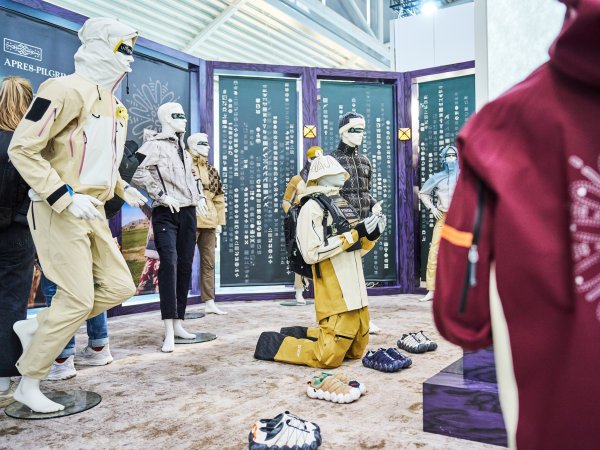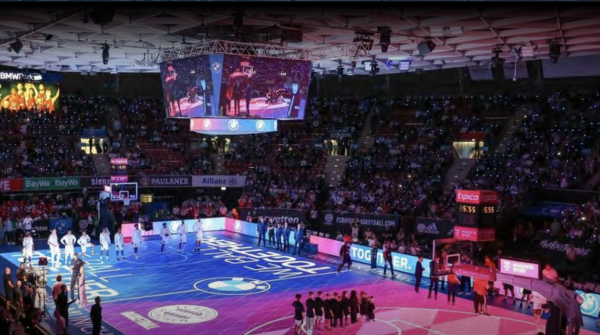The goal of store design is to create an environment in which customers feel comfortable and inspired. Outdoor enthusiasts, in particular, have a greater interest in nature conservation because they have more direct contact with nature and often develop a deeper awareness of environmental issues through their activities. Therefore, it can be advantageous for stores to demonstrate their commitment to sustainability through their design. This can be a decisive factor, especially in an era of more conscious consumption. There are many ways to achieve sustainable store design, ranging from improved energy efficiency and waste prevention to using recyclable or compostable mannequins.
Switching to LED lighting is a very efficient way to save electricity. Since retail spaces are almost always lit, energy-efficient LED lighting systems can make a significant difference. LED lights require 80 to 90 percent less electricity than traditional light bulbs and have a significantly longer service life. Although LED lights were very expensive ten years ago, their price has fallen as they have become more widespread. Another innovative solution is to return to daylight. Stores can be designed to let in more natural light. This can be achieved through skylights, large windows, and reflective surfaces, as seen in the new Adidas store in Los Angeles that opened in fall 2024, or by removing the back walls of shop windows. A smart lighting system can adjust the store's lighting requirements to changing daylight conditions.
Smart thermostats and energy management systems are also becoming increasingly important for the sustainable management of retail space. They automatically regulate heating or cooling requirements, ensuring that energy is only consumed when needed. As is so often the case, these measures not only protect the environment, but also save money.
Finally, digital product presentations can help conserve resources. Instead of using new printed merchandise for each collection, screens can be used to reduce waste and serve as interactive touchpoints. The whole thing becomes truly perfect when green electricity is also used.
The most important thing when furnishing a sustainable store is to use "better" materials. Today, a variety of interesting recycled materials are available that don't look old-fashioned or "eco." Construction waste, for example, can be used to produce high-quality terrazzo floor tiles, bricks, and recycled concrete. Wood and plaster waste can also be upcycled with resin and pigments to create decorative composite materials, like the checkout counter in the Carhartt WIP store in Antwerp. Recycled versions of PVC and vinyl floor coverings are also available and can be recycled again.
At the same time, nature is finding its way into many interiors through the use of natural materials, such as clay plaster, wood, stone, hemp, and bamboo. So-called "biophilic design" incorporates plants and natural light alongside natural materials, as seen in the Nike Rise store in London. Studies have shown that biophilic design can improve well-being and mood while reducing stress levels. This benefits retailers and customers alike.
The biodegradability of design elements also represents a sustainable waste disposal solution. There are now biodegradable hangers and mannequins made from bio-resins, rice powder, or raffia paper. Some of these are 3D-printed, which further reduces waste. Nevertheless, special processing makes them dimensionally stable and durable.
Want to find out more about the future of retail?
With the help of the free Retail Club at ISPO 2025, you will receive exclusive market insights and relevant industry data all year round. The Retail Club also offers access to top retailers, curated matchmaking and valuable business connections.
Used materials and furniture can be incorporated into interior design. Armchairs, carpets, curtains, wall coverings, and decorations can be sourced from existing stock, purchased secondhand, or newly manufactured from recycled materials. The Ecoalf Store in Madrid is one example. Its entire interior is 3D-printed from recycled plastic, making sustainability a fundamental design element.
However, be careful: Upcycling old furniture or materials too obviously can make a space look cheap. Simple upcycled tables and shelves, as well as recycled crates used as display cases, may not be suitable for every brand or customer. They must fit the store's identity and positioning. Renting can also be an alternative, for example, for seasonal window displays or decorations.
These days, modern retail spaces are being redesigned more frequently. The days when a store remained virtually unchanged for generations are long gone. However, completely overhauling the interior every few years is expensive and wasteful. That's why, in recent years, many shopfitting companies have developed modular systems for product presentation that can be rearranged and combined in new ways at any time. Thanks to this flexibility, stores can be redesigned at any time, creating new lines of sight and walkways and offering customers new experiences regularly. An example of this is the new Crocs Icon Store in New York, which opened in August.
Would you like to be the first to hear about the latest trends?
Then subscribe to our free Newsletter now and receive exclusive insights for your competitive advantage.
However, sustainable store design is not only about designing a space in a resource-efficient way; it is also about involving customers in the overall concept. An increasing number of stores are installing areas for secondhand products and collection boxes for used items. Some are clearing sales space to set up repair and care workshops for clothing, tents, shoes, and more. Examples include the outdoor retailer Bever in Utrecht and Veja's new flagship store in São Paulo. This allows long-term customers to participate in resource conservation as well.
A well thought-out store design can do much more than just present products attractively. It actively contributes to saving energy, using materials efficiently and extending the life cycles of fixtures and fittings. Sustainability thus becomes not just a technical or ecological aspect, but part of the brand identity and customer experience.
By relying on flexible, modular concepts, recycled materials and energy-efficient solutions, retailers are creating spaces that are economically viable, ecologically responsible and contemporary in design. This makes sustainable store design a decisive factor for the future viability of retail.
As the international flagship event of the global sports industry, ISPO offers orientation and provides insights into the latest trends. Discover innovative store concepts live on site and get inspiration from best practices. The free ISPO Retail Club 2025 enables retailers to network with industry experts and offers year-round access to exclusive market insights for your competitive advantage. From 30. NOV. - 02. DEZ. in Munich.
- Improve energy efficiency: LEDs, daylight and smart systems reduce power consumption and costs.
- Choose sustainable materials: Recycled, bio-based and recyclable materials create modern, resource-efficient spaces.
- Use biophilic design: Natural light, plants and natural materials increase well-being and brand loyalty.
- Circular planning: modular, rentable or recyclable furnishings extend life cycles and reduce waste.
- Make targeted use of upcycling: Recycled elements should have a high-quality appearance and fit in with the brand identity.
- Think digital: Screens and interactive displays replace print materials and save resources.
- Involve customers: Services such as repair, rental or second-hand offers make sustainability tangible.
 Sports BusinessSports retail in transition: the future playbook for 2025
Sports BusinessSports retail in transition: the future playbook for 2025
- ISPO awards
- Mountain sports
- Bike
- Design
- Retail
- Fitness
- Health
- ISPO Job Market
- ISPO Munich
- ISPO Shanghai
- Running
- Brands
- Sustainability
- Olympia
- OutDoor
- Promotion
- Sports Business
- ISPO Textrends
- Triathlon
- Water sports
- Winter sports
- eSports
- SportsTech
- OutDoor by ISPO
- Heroes
- Transformation
- Sport Fashion
- Urban Culture
- Challenges of a CEO
- Trade fairs
- Sports
- Find the Balance
- Product reviews
- Newsletter Exclusive Area
- Magazine




